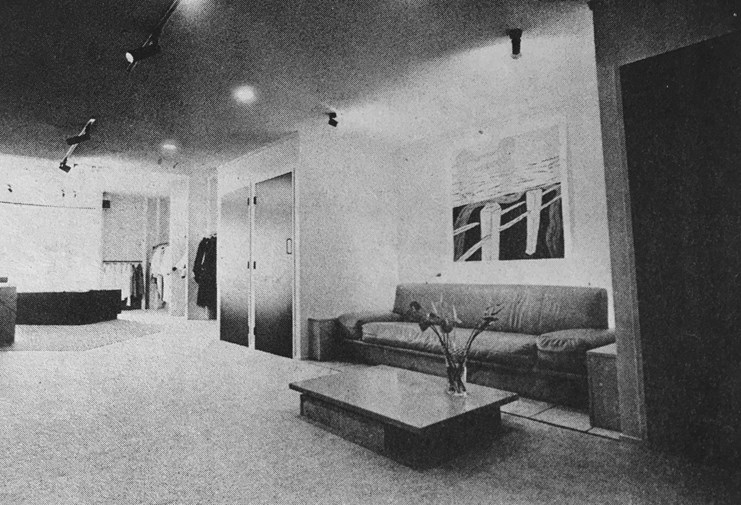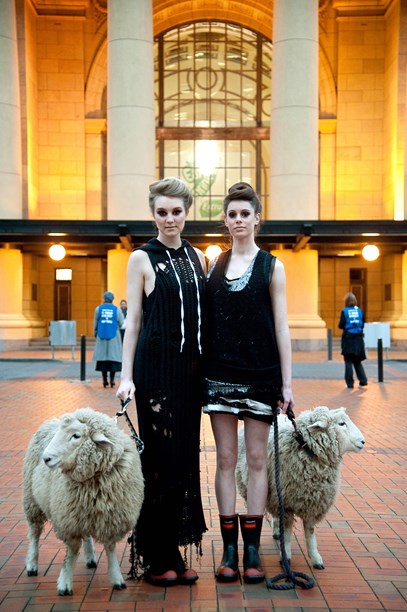Stories
Zambesi
1979-

Zambesi is not only one of New Zealand's most iconic labels, but also one of its longest-running. Launched by Elisabeth and Neville Findlay in 1979, the brand is renowned for its directional designs, which have garnered international attention, gathered a dedicated fan base and inspired a new generation of designers.
Hallmarks include intelligent, unexpected use of fabric and layers, impeccable tailoring and finishing, and an often dark colour palette, supplemented with lighter pieces and delicate fabrics designed in-house.
Fabric is usually a starting point for Elisabeth, who collects pieces ready for use when the time is right. She is also inspired by elements of vintage pieces, including a particular dress of her mother's, which numerous garments have referenced.
One of six children, Elisabeth was born in 1948 in Greece, immigrating with her family to Dunedin in 1951. Her mother Zinovia loved to sew and manipulate patterns, and passed these skills onto her children. "My mother was a great influence on my career with her passion for fabrics and her creativity and style," Elisabeth says.
With sister Margarita Robertson – who has her own successful label, NOM*d - Elisabeth spent her formative years shopping at Dunedin's fabric and second-hand stores.
In 1969, she moved to Auckland to gain work experience. That same year, she met Neville, an industrial designer, whom she married in 1971. Although Elisabeth had no formal training, she gained experience at a number of Auckland businesses, including manufacturer Derek Batts, the boutique Fotheringay on Karangahape Road, and textile importer Angus Fabrics.
With their combined experience, Elisabeth and Neville saw the opportunity to open their own boutique. Tart opened in Parnell in 1975, stocking Elisabeth's designs alongside other New Zealand designers such as Wendy Ganley's label, Elle and Marilyn Sainty. "My desire was to choose pieces I identified with and labels I admired and create a unique environment," Elisabeth says.
The success of this store led the pair to open another, Cachet, in Takapuna in 1978. This remained open until the mid-90s (albeit with a slight change in location). Cachet also stocked Elisabeth's designs and sold on behalf of emerging designers. The store's interior set the scene for the innovative retail environments that would become the Findlays' signature, thanks to Neville's background and creative vision.

The interior of Cachet in Anzac Ave, 1984. Image © ChaCha magazine.
Neville left his job to work full-time on the couple's businesses in 1978. In 1979, "Zambesi was launched, when we felt the inspiration to create our own label and distinctive retail and brand culture," explains Elisabeth.
An early Zambesi design from 1980. Image © Puke Ariki, TM1999.016.
Alongside Britomart, Zambesi currently has boutiques in Ponsonby, Newmarket, Wellington and Melbourne. The brand also has stockists throughout New Zealand, Australia and Asia, and an online store. Pieces from international designers such as Maison Martin Margiela and Rick Owens complement their collections in store.
Although initially a womenswear label, menswear is now an integral part of the brand. In the 1980s and 1990s, the Findlays opened two Zambesi Man stores, one in Takapuna, and a second in Vulcan Lane. This second store was operated by Murray Crane of Crane Brothers, and subsequently, his brother Mark; both were instrumental in establishing Zambesi menswear.
Designer Dayne Johnston became the brand's fulltime menswear designer in 2004, after having worked in finishing and quality control.
Dayne and Elisabeth design their collections separately, but work together on fabrics, and bring elements from each other's collections into their lines. Garments from Zambesi's Autumn/Winter 2011 collection. Image © Zambesi.
Dayne's signatures include experimentation with details and attention to cut and tailoring. "Dayne is not afraid to experiment and instinctively understands the integrity and the spirit of the brand," Elisabeth is quoted in New Zealand Fashion Design (Lassig, 2010).
Manufacturing locally is an important aspect of Zambesi's ethos. The Auckland workroom is home to a number of dedicated pattern-makers, machinists and finishers, some of whom have been working for the brand for over two decades. A number of outworkers have also worked with the Findlays for over 30 years.
Zambesi's Winter 14 collection celebrated this commitment to local production, incorporating local motifs and fabrics, and a slogan which declared the brand 'Home-made since '79'.
Being New Zealand made is "very much part of what Zambesi stands for, and our original vision for the brand," says Elisabeth. It's an impressive stand in the current retail market, where many labels have turned to offshore manufacturing to compete.

'Shredded hoodie' by NOM*d (left) and 'OTT' by Zambesi at Shear Brilliance, the launch of the campaign for Wool in New Zealand in 2011. Image © the Campaign for Wool.
Luckily, Zambesi's customers are legendary in their dedication. Many dress head-to-toe in the label, adding new pieces each year to their previous season's collection. The merging of seasons works because of the brand's timeless, non-trend driven aesthetic, and Elisabeth's technique of referencing her past designs.
This cohesiveness was showcased beautifully in two retrospectives - the exhibition Zambesi, Edge of Darkness at the Auckland War Memorial Museum in 2005, and Zambesi's 30th birthday show, which closed New Zealand Fashion Week in 2009.
Other ranges have included eyewear, introduced in 2012, and, from 2005-2011, the uniforms for Air New Zealand, designed in a locally-inspired colour palette of teal, greenstone and schist. Currently, the brand are in the process of developing a Zambesi fragrance. Otherwise it's business as usual. "Our focus is always on our next collection."
When recalling highlights of the brand's 40 years, Elisabeth points to the runway shows. She remembers receiving a standing ovation after Zambesi's first showing at Australian Fashion Week in 1997, and being selected in 1999 to show at London Fashion Week as part of the New Zealand Four.

This combination of a hoop skirt, vest and leggings featured on Zambesi’s invitation for their show at London Fashion Week in 1999.
In the early 1990s, Zambesi also showed regularly in the Corbans Fashion Collections, and its subsequent iterations, the Wella Fashion Collections and Wella Fashion Report.

Zambesi designs at the Corbans Fashion Collections, Spring /Summer 1993/1994.
The brand's New Zealand Fashion Week shows are always schedule highlights, with an element of theatre, and many well-known faces in the front row. Memorable shows have included one at the Auckland War Memorial Museum for the first L'Oreal New Zealand Fashion Week in 2001; a rock 'n' roll St James Theatre showing in 2005; and 2013's dramatic moment, where one wall was pulled back to reveal Elisabeth, Dayne and a team of hair and makeup artists readying the models for the runway. In 2019, they held two Fashion Week shows - a presentation of their A/W 2020 collection at the Auckland Public Library and a retrospective show that highlights Zambesi's most memorable designs from 1979 to 2019.
The Findlay's oldest daughter Marissa Findlay is responsible for producing and casting these shows, while younger daughter Sophie selects and edits the show music. Elisabeth relishes this family connection, saying "Neville [and] my daughters Marissa and Sophie have been a great influence on my career, with their individual creative input and their unconditional support of my vision."
Marissa, a freelance photographer, has also been photographing the distinctive Zambesi campaigns since she was in high school. The next generation is involved too, with the Findlays' grandson Bruno having modelled in a number of shows.
Elisabeth and Neville's services to business and fashion were recognised in 2008 when they both became Officers of the New Zealand Order of Merit.
Text by Fiona Ralph. Banner image © Elisabeth and Neville Findlay.
Published November 2015, updated August 2019.